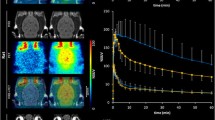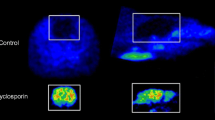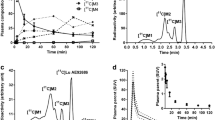Abstract
Purpose
Pretreatment with cyclosporine, a P-glycoprotein (P-gp) modulator increases brain uptake of 4-(2'-methoxyphenyl)-1-[2'-(N-2"-pyridinyl)-p-[18F]fluorobenzamido]ethylpiperazine ([18F]MPPF) for binding to hydroxytryptamine1A (5-HT1A) receptors. Those increases were quantified in rat brain with in vivo microPET and ex vivo tissue studies.
Materials and methods
Each Sprague–Dawley rat (n = 4) received a baseline [18F]MPPF microPET scan followed by second scan 2–3 weeks later that included cyclosporine pretreatment (50 mg/kg, i.p.). Maximum a posteriori reconstructed images and volumetric ROIs were used to generate dynamic radioactivity concentration measurements for hippocampus, striatum, and cerebellum, with simplified reference tissue method (SRTM) analysis. Western blots were used to semiquantify P-gp regional distribution in brain.
Results
MicroPET studies showed that hippocampus uptake of [18F]MPPF was increased after cyclosporine; ex vivo studies showed similar increases in hippocampus and frontal cortex at 30 min, and for heart and kidney at 2.5 and 5 min, without concomitant increases in [18F]MPPF plasma concentration. P-gp content in cerebellum was twofold higher than in hippocampus or frontal cortex.
Conclusions
These studies confirm and extend prior ex vivo results (J. Passchier, et al., Eur J Pharmacol, 2000) that showed [18F]MPPF as a substrate for P-gp. Our microPET results showed that P-gp modulation of [18F]MPPF binding to 5-HT1A receptors can be imaged in rat hippocampus. The heterogeneous brain distribution of P-gp appeared to invalidate the use of cerebellum as a nonspecific reference region for SRTM modeling. Regional quantitation of P-gp may be necessary for accurate PET assessment of 5-HT1A receptor density when based on tracer uptake sensitive to P-gp modulation.






Similar content being viewed by others
References
Moore AH, Hovda DA, Cherry SR, Villablanca JP, Pollack DB, Phelps ME. Dynamic changes in cerebral glucose metabolism in conscious infant monkeys during the first year of life as measured by positron emission tomography. Brain Res Dev Brain Res 2000;120:141–50.
Morris ED, Chefer SI, Lane MA, Muzic RF Jr., Wong DF, Dannals RF, et al. Loss of D2 receptor binding with age in rhesus monkeys: importance of correction for differences in striatal size. J Cereb Blood Flow Metab 1999;19:218–29.
Melega WP, Quintana J, Raleigh MJ, Stout DB, Yu DC, Lin KP, et al. 6-[18F]Fluoro-l-DOPA-PET studies show partial reversibility of long-term effects of chronic amphetamine in monkeys. Synapse 1996;22:63–9.
Melega WP, Raleigh MJ, Stout DB, DeSalles AA, Blurton-Jones M, Cherry SR, et al. Longitudinal behavioral and 6-[18F]Fluoro-l-DOPA-PET assessment in MPTP-hemiparkinsonian monkeys. Exp Neurol 1996;141:318–29.
Melega WP, Lacan G, Desalles AA, Phelps ME. Long-term methamphetamine-induced decreases of [(11)C]WIN 35,428 binding in striatum are reduced by GDNF: PET studies in the vervet monkey. Synapse 2000;35:243–9.
Bankiewicz KS, Eberling JL, Kohutnicka M, Jagust W, Pivirotto P, Bringas J, et al. Convection-enhanced delivery of AAV vector in parkinsonian monkeys; in vivo detection of gene expression and restoration of dopaminergic function using pro-drug approach. Exp Neurol 2000;164:2–14.
Chatziioannou AF, Cherry SR, Shao Y, Silverman RW, Meadors K, Farquhar TH, et al. Performance evaluation of microPET: a high-resolution lutetium oxyorthosilicate PET scanner for animal imaging. J Nucl Med 1999;40:1164–75.
Rubins DJ, Meadors AK, Yee S, Melega WP, Cherry SR. Evaluation of a stereotactic frame for repositioning of the rat brain in serial positron emission tomography imaging studies. J Neurosci Methods 2001;107:63–70.
Rubins DJ, Melega WP, Lacan G, Way B, Plenevaux A, Luxen A, et al. Development and evaluation of an automated atlas-based image analysis method for microPET studies of the rat brain. Neuroimage 2003;20:2100–18.
Lee G, Dallas S, Hong M, Bendayan R. Drug transporters in the central nervous system: brain barriers and brain parenchyma considerations. Pharmacol Rev 2001;53:569–96.
Schinkel AH. P-Glycoprotein, a gatekeeper in the blood–brain barrier. Adv Drug Deliv Rev 1999;36:179–94.
Passchier J, van Waarde A, Doze P, Elsinga PH, Vaalburg W. Influence of P-glycoprotein on brain uptake of [18F]MPPF in rats. Eur J Pharmacol 2000;407:273–80.
Le Bars D, Lemaire C, Ginovart N, Plenevaux A, Aerts J, Brihaye C, et al. High-yield radiosynthesis and preliminary in vivo evaluation of p-[18F]MPPF, a fluoro analog of WAY-100635. Nucl Med Biol 1998;25:343–50.
Chatziioannou A, Qi J, Moore A, Annala A, Nguyen K, Leahy R, et al. Comparison of 3-D maximum a posteriori and filtered backprojection algorithms for high-resolution animal imaging with microPET. IEEE Trans Med Imaging 2000;19:507–12.
Luke DR, Brunner LJ, Vadiei K. Bioavailability assessment of cyclosporine in the rat. Influence of route of administration. Drug Metab Dispos 1990;18:158–62.
Qi J, Leahy RM, Cherry SR, Chatziioannou A, Farquhar TH. High-resolution 3D Bayesian image reconstruction using the microPET small-animal scanner. Phys Med Biol 1998;43:1001–13.
Siegel S, Dalboum M. Implementation and evaluation of a calculated attenuation correction for PET. IEEE Transactions on Nuclear Science 1992;39:1117–21.
Studholme C, Hill DL, Hawkes DJ. Automated three-dimensional registration of magnetic resonance and positron emission tomography brain images by multiresolution optimization of voxel similarity measures. Medical Physics 1997;24:25–35.
Lammertsma AA, Hume SP. Simplified reference tissue model for PET receptor studies. Neuroimage 1996;4:153–58.
Marcinkiewicz M, Verge D, Gozlan H, Pichat L, Hamon M. Autoradiographic evidence for the heterogeneity of 5-HT1 sites in the rat brain. Brain Res 1984;291:159–63.
Plenevaux A, Weissmann D, Aerts J, Lemaire C, Brihaye C, Degueldre C, et al. Tissue distribution, autoradiography, and metabolism of 4-(2'-methoxyphenyl)-1-[2' -[N-2"-pyridinyl)-p-[(18)F]fluorobenzamido]ethyl]piperazine (p-[(18)F]MPPF), a new serotonin 5-HT(1A) antagonist for positron emission tomography: An In vivo study in rats. J Neurochem 2000;75:803–11.
van Vliet EA, van Schaik R, Edelbroek PM, Voskuyl RA, Redeker S, Aronica E, et al. Region-specific overexpression of P-glycoprotein at the blood–brain barrier affects brain uptake of phenytoin in epileptic rats. J Pharmacol Exp Ther 2007;322:141–7.
Lee G, Schlichter L, Bendayan M, Bendayan R. Functional expression of P-glycoprotein in rat brain microglia. J Pharmacol Exp Ther 2001;299:204–12.
Babakhanian K, Bendayan M, Bendayan R. Localization of P-glycoprotein at the nuclear envelope of rat brain cells. Biochem Biophys Res Commun 2007;361:301–6.
Landry M, Di Paolo T. Effect of chronic estradiol, tamoxifen or raloxifene treatment on serotonin 5-HT1A receptor. Brain Res Mol Brain Res 2003;112:82–9.
Welner SA, De Montigny C, Desroches J, Desjardins P, Suranyi-Cadotte BE. Autoradiographic quantification of serotonin1A receptors in rat brain following antidepressant drug treatment. Synapse 1989;4:347–52.
Khawaja X. Quantitative autoradiographic characterisation of the binding of [3H]WAY-100635, a selective 5-HT1A receptor antagonist. Brain Res 1995;673:217–25.
Schinkel AH, Wagenaar E, Mol CA, van Deemter L. P-glycoprotein in the blood-brain barrier of mice influences the brain penetration and pharmacological activity of many drugs. J Clin Invest 1996;97:2517–24.
Loscher W, Potschka H. Role of multidrug transporters in pharmacoresistance to antiepileptic drugs. J Pharmacol Exp Ther 2002;301:7–14.
Loscher W. Mechanisms of drug resistance. Epileptic Disord 2005;7(Suppl 1):3–9.
Balayssac D, Authier N, Cayre A, Coudore F. Does inhibition of P-glycoprotein lead to drug-drug interactions? Toxicol Lett 2005;156:319–29.
Hendrikse NH, Franssen EJ, van der Graaf WT, Vaalburg W, de Vries EG. Visualization of multidrug resistance in vivo. Eur J Nucl Med 1999;26:283–93.
Hendrikse NH, de Vries EG, Eriks-Fluks L, van der Graaf WT, Hospers GA, Willemsen AT, et al. A new in vivo method to study P-glycoprotein transport in tumors and the blood-brain barrier. Cancer Res 1999;59:2411–6.
Bart J, Willemsen AT, Groen HJ, van der Graaf WT, Wegman TD, Vaalburg W, et al. Quantitative assessment of P-glycoprotein function in the rat blood-brain barrier by distribution volume of [11C]verapamil measured with PET. Neuroimage 2003;20:1775–82.
Hsiao P, Sasongko L, Link JM, Mankoff DA, Muzi M, Collier AC, et al. Verapamil P-glycoprotein transport across the rat blood–brain barrier: cyclosporine, a concentration inhibition analysis, and comparison with human data. J Pharmacol Exp Ther 2006;317:704–10.
Bart J, Dijkers EC, Wegman TD, de Vries EG, van der Graaf WT, Groen HJ, et al. New positron emission tomography tracer [(11)C]carvedilol reveals P-glycoprotein modulation kinetics. Br J Pharmacol 2005;145:1045–51.
Ishiwata K, Kawamura K, Yanai K, Hendrikse NH. In vivo evaluation of P-glycoprotein modulation of 8 PET radioligands used clinically. J Nucl Med 2007;48:81–7.
Balle T, Halldin C, Andersen L, Hjorth Alifrangis L, Badolo L, Gjervig Jensen K, et al. New alpha(1)-adrenoceptor antagonists derived from the antipsychotic sertindole—carbon-11 labelling and pet examination of brain uptake in the cynomolgus monkey. Nucl Med Biol 2004;31:327–36.
Sasongko L, Link JM, Muzi M, Mankoff DA, Yang X, Collier AC, et al. Imaging P-glycoprotein transport activity at the human blood–brain barrier with positron emission tomography. Clin Pharmacol Ther 2005;77:503–14.
Lee Y-J, Kusuhara H, Sugiyama Y. Lack of contribution of P-Glycoprotein (P-gp) to transport via the mouse blood–cerebrospinal fluid barrier. J Health Sciences 2005;51:101–05.
Nikolaus S, Larisch R, Beu M, Vosberg H, Muller-Gartner HW. Imaging of striatal dopamine D(2) receptors with a PET system for small laboratory animals in comparison with storage phosphor autoradiography: a validation study with (18)F-(N-methyl)benperidol. J Nucl Med 2001;42:1691–6.
Jagoda EM, Vaquero JJ, Seidel J, Green MV, Eckelman WC. Experiment assessment of mass effects in the rat: implications for small animal PET imaging. Nucl Med Biol 2004;31:771–9.
Costes N, Merlet I, Ostrowsky K, Faillenot I, Lavenne F, Zimmer L, et al. A 18F-MPPF PET normative database of 5-HT1A receptor binding in men and women over aging. J Nucl Med 2005;46:1980–9.
Passchier J, van Waarde A, Vaalburg W, Willemsen AT. On the quantification of [18F]MPPF binding to 5-HT1A receptors in the human brain. J Nucl Med 2001;42:1025–31.
Lanfumey L, Hamon M. Central 5-HT(1A) receptors: regional distribution and functional characteristics. Nucl Med Biol 2000;27:429–35.
Slifstein M, Laruelle M. Models and methods for derivation of in vivo neuroreceptor parameters with PET and SPECT reversible radiotracers. Nucl Med Biol 2001;28:595–608.
Ichise M, Meyer JH, Yonekura Y. An introduction to PET and SPECT neuroreceptor quantification models. J Nucl Med 2001;42:755–63.
Matsuoka Y, Okazaki M, Kitamura Y, Taniguchi T. Developmental expression of P-glycoprotein (multidrug resistance gene product) in the rat brain. J Neurobiol 1999;39:383–92.
Seegers U, Potschka H, Loscher W. Expression of the multidrug transporter P-glycoprotein in brain capillary endothelial cells and brain parenchyma of amygdala-kindled rats. Epilepsia 2002;43:675–84.
Liow JS, Lu S, McCarron JA, Hong J, Musachio JL, Pike VW, et al. Effect of a P-glycoprotein inhibitor, Cyclosporin A, on the disposition in rodent brain and blood of the 5-HT1A receptor radioligand, [11C](R)-(−)-RWAY. Synapse 2007;61:96–105.
Zhang XY, Yasuno F, Zoghbi SS, Liow JS, Hong J, McCarron JA, et al. Quantification of serotonin 5-HT(1A) receptors in humans with [(11)C](R)-(−)-RWAY: Radiometabolite(s) likely confound brain measurements. Synapse 2007;61:469–77.
Passchier J, van Waarde A, Pieterman RM, Elsinga PH, Pruim J, Hendrikse HN, et al. Quantitative imaging of 5-HT(1A) receptor binding in healthy volunteers with [(18)f]p-MPPF. Nucl Med Biol 2000;27:473–6.
Syvanen S, Blomquist G, Sprycha M, Hoglund AU, Roman M, Eriksson O, et al. Duration and degree of cyclosporin induced P-glycoprotein inhibition in the rat blood–brain barrier can be studied with PET. Neuroimage 2006;32:1134–41.
Solbach TF, Konig J, Fromm MF, Zolk O. ATP-binding cassette transporters in the heart. Trends Cardiovasc Med 2006;16:7–15.
Volk HA, Potschka H, Loscher W. Increased expression of the multidrug transporter P-glycoprotein in limbic brain regions after amygdala-kindled seizures in rats. Epilepsy Res 2004;58:67–79.
Volk HA, Loscher W. Multidrug resistance in epilepsy: rats with drug-resistant seizures exhibit enhanced brain expression of P-glycoprotein compared with rats with drug-responsive seizures. Brain 2005;128:1358–68.
Sisodiya SM, Lin WR, Harding BN, Squier MV, Thom M. Drug resistance in epilepsy: expression of drug resistance proteins in common causes of refractory epilepsy. Brain 2002;125:22–31.
Merlet I, Ostrowsky K, Costes N, Ryvlin P, Isnard J, Faillenot I, et al. 5-HT1A receptor binding and intracerebral activity in temporal lobe epilepsy: an [18F]MPPF-PET study. Brain 2004;127:900–13.
Kerb R. Implications of genetic polymorphisms in drug transporter for pharmacotherapy. Cancer Letters 2006;234:4–33.
Acknowledgments
The authors thank the entire radiochemistry group (Dr. Nagichettiar Satyamurthy, Director), and Judy Edwards and Dr. Waldemar Ladno of the microPET imaging section (Dr. Arion Chatziioannou, Director) at UCLA.
We also thank Professor Wolfgang Lőscher (University of Veterinary Medicine, Hannover, Germany) and Dr. Erwin van Vliet (Center for Neurosciences, University of Amsterdam, The Netherlands) for their helpful comments regarding P-gp quantification in the rat brain.
This research was supported in part by a contract from the U.S. Department of Energy (DoE) DE-FC03-87ER60615, FRS-FNRS Belgium (grant 3.4557.03F) and the Liege University (“Fonds Spéciaux” projects C-03/72 and C-02/23). A. Plenevaux is a research associate from FRS-FNRS Belgium.
Declaration of compliance for experiments performed
All procedures were performed in accordance with established practices as described in the Guide for the Care and Use of Laboratory Animals (National Research Council, 1996). All protocols were reviewed and approved by the UCLA Chancellor’s Animal Research Committee and Liege University Animal Ethics Committee.
Conflict of Interest statement
None of the authors has a conflict of interest related to the subject of this report.
Author information
Authors and Affiliations
Corresponding author
Rights and permissions
About this article
Cite this article
Laćan, G., Plenevaux, A., Rubins, D.J. et al. Cyclosporine, a P-glycoprotein modulator, increases [18F]MPPF uptake in rat brain and peripheral tissues: microPET and ex vivo studies. Eur J Nucl Med Mol Imaging 35, 2256–2266 (2008). https://doi.org/10.1007/s00259-008-0832-z
Received:
Accepted:
Published:
Issue Date:
DOI: https://doi.org/10.1007/s00259-008-0832-z




